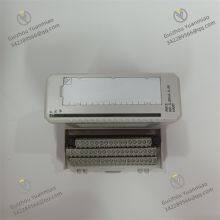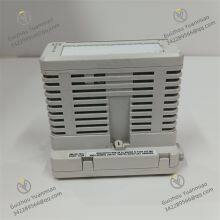I. Product Overview
ABB AI815 3BSE052604R1 is an analog input module. It adopts a compact structural layout with an overall size of 10.2cm × 4.5cm × 11.9cm. This sophisticated design enables it to be efficiently installed in various control cabinets, whether it is a small automation device with limited space or a large and complex industrial control system cabinet, it can be easily adapted, effectively saving installation space. The module weighs only 0.3kg, which is convenient for installers to operate and reduces additional load costs during installation and transportation.
The shell is made of high-quality materials with good protective performance, which can resist a certain degree of physical impact and has a good protective effect against common industrial pollutants such as dust and oil stains, ensuring that the internal precision circuits are not disturbed by the external environment, and laying a foundation for the long-term stable operation of the module in complex industrial environments.
The main function of the AI815 module is to realize the accurate collection and input of analog signals. It can be connected to various sensor devices, such as pressure sensors, temperature sensors, flow sensors, etc. It can accurately collect and transmit analog signals from sensors, such as 0-5V voltage signals or 4-20mA current signals, to the control system, providing real-time and reliable on-site data for the control system, and is a key component in building the data collection link of the automated control system.

II. Performance Parameters
(1) Electrical Characteristics
Power supply requirements: This module is usually adapted to common industrial power supply specifications. The specific power supply voltage range is stable and wide, and it can work normally under voltage fluctuations of [specific voltage range, such as 24VDC ± 10%]. This enables it to seamlessly interface with most industrial DC power supply systems without complex voltage conversion equipment, greatly simplifying the system integration process and reducing the risk of failures caused by power supply adaptation issues.
Power consumption performance: In normal working conditions, the AI815 module has low power consumption, only 3.5W. The low-power design not only helps reduce the energy consumption of the overall system and reduce operating costs but also effectively reduces the heat generation of the module itself. The lower heat generation can extend the service life of the electronic components inside the module, improve the stability of the module in long-term continuous working conditions, and provide a strong guarantee for the reliable operation of the system.
(2) Input Characteristics
Input types and ranges: AI815 supports two common analog input types: voltage and current. The voltage input range can be set to 0-5V, which can accurately collect sensor data corresponding to the voltage signal range; the current input range is 4-20mA, which is suitable for many industrial standard current-type sensors. It is worth noting that voltage and current input types cannot be mixed on the same module. This design helps ensure the stability and accuracy of signal collection and avoids interference between different types of signals.
Number of input channels: The module is equipped with 8 input channels, which can be connected to multiple sensors at the same time to realize synchronous collection of data from multiple measurement points. This design greatly improves the efficiency of data collection. In industrial scenarios where multiple parameters need to be monitored, such as temperature and pressure monitoring of multiple reactors in chemical production processes, or monitoring of operating parameters of multiple devices in power systems, it can significantly reduce the number of required modules, lower system costs and wiring complexity.
Resolution: It has a high resolution of 12 bits, which means it can perform extremely fine quantization processing on the input analog signal. The high resolution enables the module to detect extremely small changes in the signal. For example, for the analog signal output by the temperature sensor, it can accurately distinguish the slight fluctuations in temperature, thereby providing more accurate data for the control system and meeting the strict requirements for high-precision measurement and control in industrial production processes.
Input impedance: For different input types, the AI815 module is set with reasonable input impedance. When inputting voltage, the input impedance is 10MΩ, which can effectively reduce the impact on the input voltage signal and ensure accurate collection of the real voltage value; when inputting current (including PTC), the input impedance is 250Ω, which matches well with the industrial standard 4-20mA current loop, ensuring the stability and accuracy of the current signal during transmission and collection.
(3) Communication and Protocols
Communication method: Data transmission between the AI815 module and the control system is carried out through standard communication interfaces, such as [list actual communication interfaces, such as Profibus-DP, Modbus TCP, etc.]. These communication interfaces are widely used in the field of industrial automation, with high-speed and stable data transmission capabilities, which can meet the needs of automated control systems with high real-time requirements for fast data transmission.
Protocol support: It supports a variety of mainstream industrial communication protocols, such as Modbus protocol, which is widely used in the interconnection of industrial equipment, enabling the AI815 module to easily communicate seamlessly with other devices and control systems that follow the Modbus protocol. Through these communication protocols, the module can not only accurately transmit the collected analog data to the control system but also receive configuration and control commands sent by the control system to achieve two-way data interaction.
(4) Reliability Characteristics
Electrical isolation: In order to improve system safety and reduce noise interference, the AI815 module provides effective electrical isolation between the input channel and the controller. This isolation technology can prevent external electrical interference from entering the control system through the input channel and affecting the normal operation of the system. For example, in industrial environments with a large number of high-voltage equipment and high-frequency interference sources, electrical isolation can ensure that the data collected by the module is not disturbed, and at the same time protect the controller from possible electrical faults, improving the reliability and stability of the entire system.
Overvoltage/undervoltage protection: The module has a reliable overvoltage/undervoltage protection function, which can withstand overvoltage or undervoltage of at least 11VDC. When the input voltage exceeds the normal working range, the protection circuit will start automatically to prevent excessive or too low voltage from damaging the internal circuit of the module, ensuring that the module can still maintain normal working status under abnormal voltage fluctuations, extending the service life of the module and reducing maintenance costs.
Self-diagnostic function: It has a perfect self-diagnostic function, which can monitor its own working status in real-time. The module can continuously monitor key parameters such as power supply status, communication status, and input channel status. Once an abnormal situation is detected, such as power failure, communication interruption, channel short circuit or open circuit, it will immediately send an alarm signal. On the one hand, the alarm information is uploaded to the control system through the communication interface, which is convenient for operators to know the fault situation in time; on the other hand, the fault indicator light on the module will be lit accordingly, providing an intuitive indication for maintenance personnel to quickly locate the fault point, greatly shortening the fault troubleshooting and repair time, and improving the availability of the system.
Environmental adaptability
Operating temperature range: The AI815 module can work stably in a wide temperature range of -25°C to +70°C. Whether it is in cold outdoor industrial facilities, such as oil extraction sites in northern winter, or in high-temperature industrial production workshops, such as high-temperature areas of steel mills, the module can operate normally, ensuring that data collection is not affected by changes in environmental temperature, and maintaining the continuity and accuracy of the automated control system.
Humidity adaptability: It can work reliably in an environment with a relative humidity of 5% to 95% (non-condensing). In humid industrial environments, such as paper mills and food processing plants, the module will not have problems such as reduced electrical performance and short circuits due to humidity, ensuring stable operation under different humidity conditions and expanding its application range in various industrial scenarios.
Vibration and impact resistance: It has undergone strict vibration and impact tests and has good vibration and impact resistance. The module can still work normally under vibration conditions with a vibration frequency of [specific frequency range, such as 10-500Hz] and an acceleration of [specific acceleration value, such as 5g], and under impact conditions with an impact acceleration of [specific impact acceleration value, such as 30g]. This enables it to maintain stable operation during transportation, installation, and when near industrial equipment with large vibrations, ensuring that data collection and transmission are not disturbed by vibration and impact.

III. Application Scenarios
(1) Power Industry
In the power generation link of the power system, the AI815 module can be connected to various sensors to monitor the operating parameters of the generator set. For example, connect temperature sensors to monitor generator winding temperature and bearing temperature, and connect pressure sensors to monitor oil pressure, air pressure and other parameters. These analog signals are collected and transmitted to the power control system. The control system can accurately regulate the generator set according to real-time data, such as adjusting the excitation current and controlling the oil intake, to ensure the stable and efficient operation of the generator set, avoid failures caused by overheating or abnormal pressure of the equipment, and improve power generation efficiency and power supply reliability.
In substations, the AI815 module is used to collect operating status signals of various equipment. For example, connect current transformers and voltage transformers to collect current and voltage signals of power lines and monitor the operating parameters of the power system; connect transformer oil temperature sensors and winding temperature sensors to keep track of the operating status of the transformer in real-time. These data are transmitted to the substation automation system, helping operation and maintenance personnel to detect equipment abnormalities in time, realize remote monitoring and intelligent management of substation equipment, and ensure the safe and stable transmission of electricity.
(2) Petroleum and Chemical Industry
The petroleum and chemical production process involves many complex process flows and a large number of equipment, so accurate monitoring and control of process parameters are crucial. The AI815 module can be connected to temperature, pressure, and liquid level sensors on the reactor, collect analog signals of these key parameters and transmit them to the Distributed Control System (DCS). The DCS adjusts the operating parameters of the reactor in real-time according to the received data, such as controlling the feeding speed and adjusting the cooling water volume, to ensure that the chemical reaction is carried out under optimal conditions, improve product quality and production efficiency, and prevent safety accidents caused by reaction out of control.
In the process of petroleum pipeline transportation, the AI815 module can be connected to flow sensors and pressure sensors to monitor the flow of petroleum and pipeline pressure in real-time. The collected data is transmitted to the pipeline monitoring system. Once abnormal flow or sudden pressure changes are found, the system can issue an alarm in time and take corresponding measures, such as closing valves and starting backup pumps, to ensure the safety and reliability of the petroleum transportation process and avoid economic losses and environmental pollution caused by pipeline leakage or blockage.
(3) Manufacturing Industry
In the automated production lines of the manufacturing industry, the AI815 module plays an important role. For example, in automobile manufacturing production lines, it can be connected to force sensors and position sensors at the robot joints to collect analog signals of force and position during the operation of the robot. These signals are transmitted to the robot control system, which is used to precisely control the robot's actions, ensuring that the robot can operate accurately in assembly, welding and other processes, and improving the processing accuracy and production quality of products.
In the electronic equipment manufacturing industry, the AI815 module can be connected to temperature sensors and humidity sensors on the production line to monitor the temperature and humidity of the production environment in real-time. The monitoring data is transmitted to the environmental control system. When the temperature and humidity exceed the set range, the system automatically starts air conditioners, dehumidifiers and other equipment for adjustment, providing stable environmental conditions for the production of electronic products and ensuring the performance and reliability of the products.
(4) Metallurgical Industry
In the steel smelting process, the AI815 module can be connected to equipment such as temperature sensors, pressure sensors, and material level sensors of the blast furnace to collect analog signals such as temperature, pressure, and material height in the blast furnace. These data are transmitted to the blast furnace automation control system, helping operators to grasp the operating status of the blast furnace in real-time, adjust operating parameters such as material distribution, air blowing, and coal injection in a timely manner, ensure the stable and smooth operation of the blast furnace, improve the output and quality of molten iron, and reduce energy consumption.
In the smelting of non-ferrous metals, such as copper, aluminum and other metals, the AI815 module can be connected to voltage sensors and current sensors of electrolytic cells to collect electrical parameter signals during electrolysis. These signals are transmitted to the smelting control system. Through precise control of electrical parameters, the electrolysis process is optimized, the extraction rate and purity of metals are improved, and production costs are reduced.












































